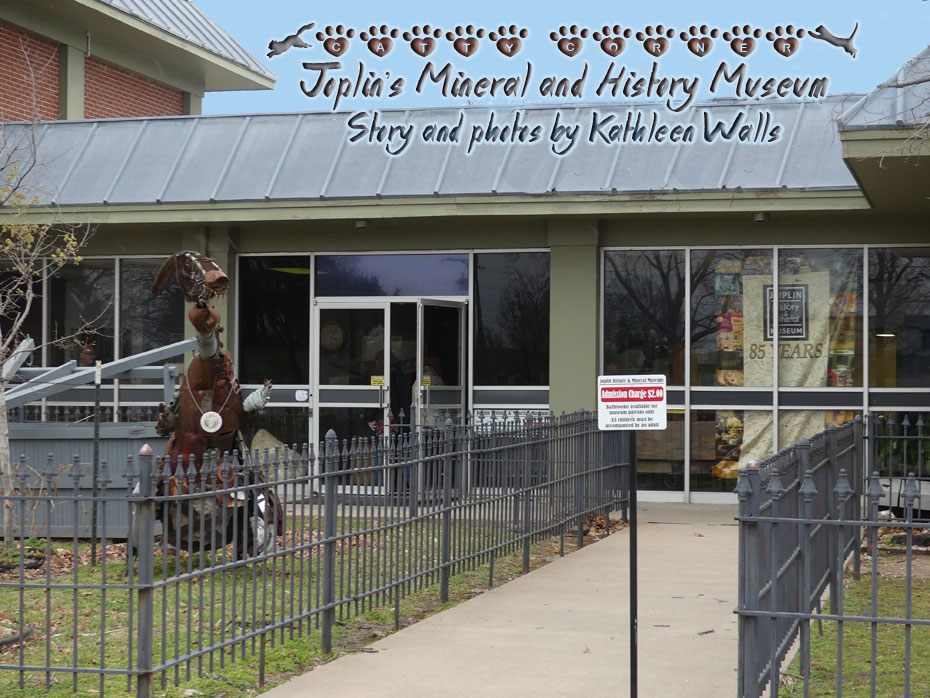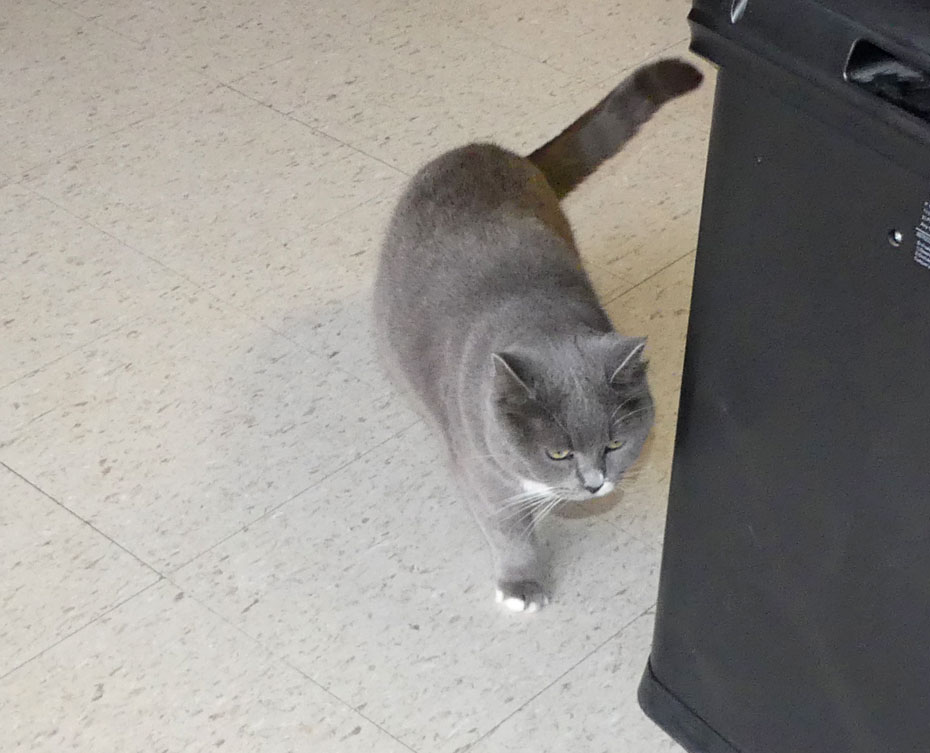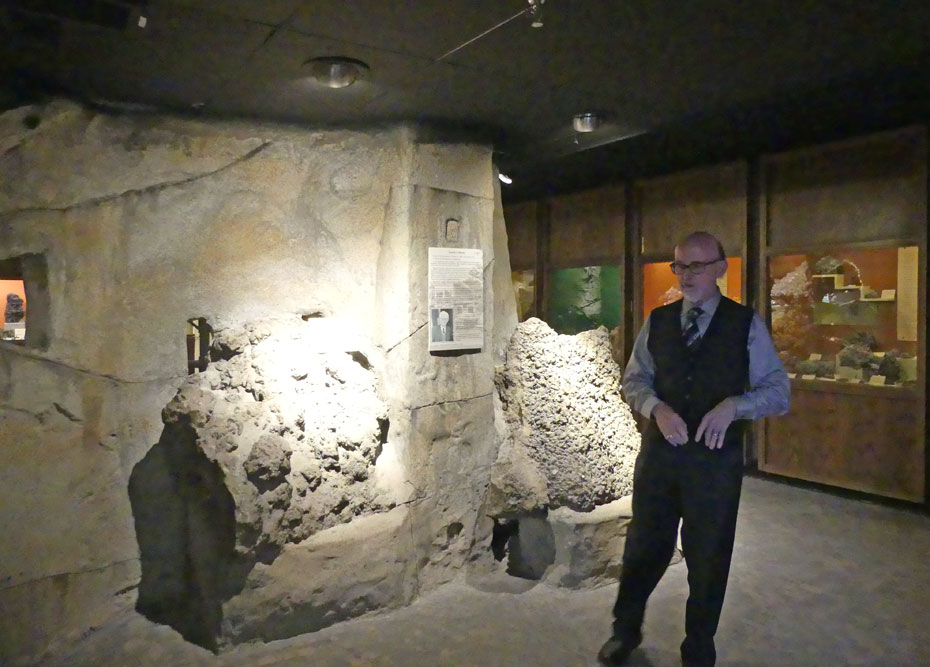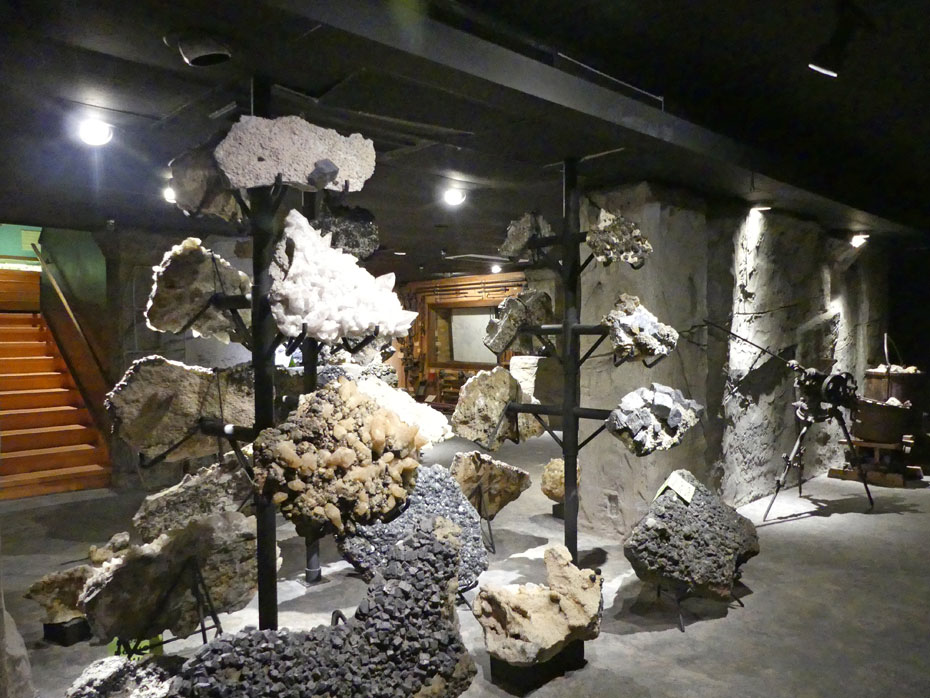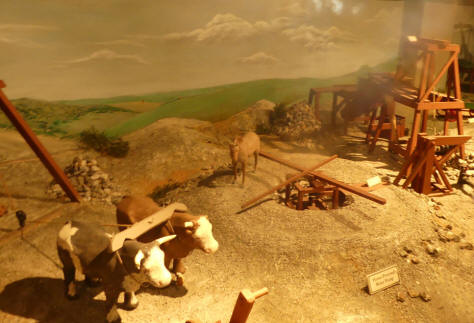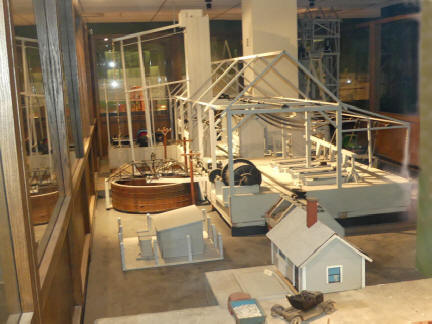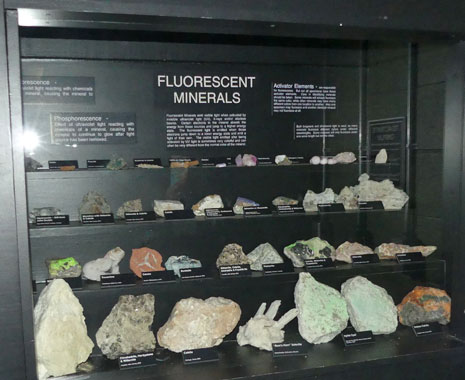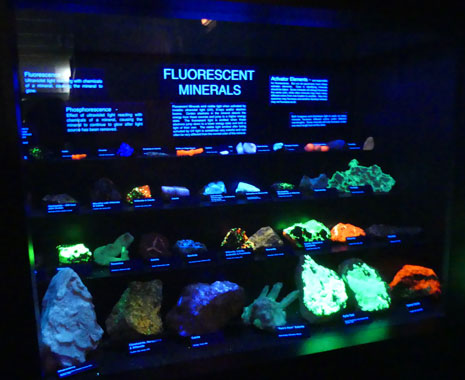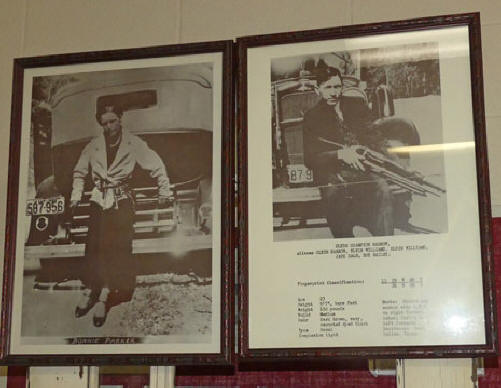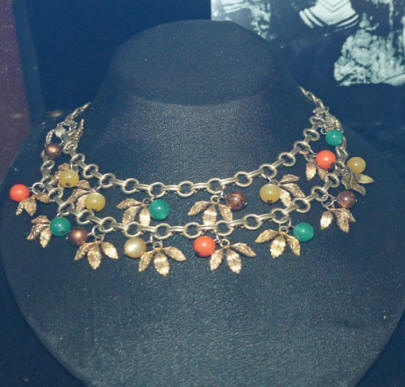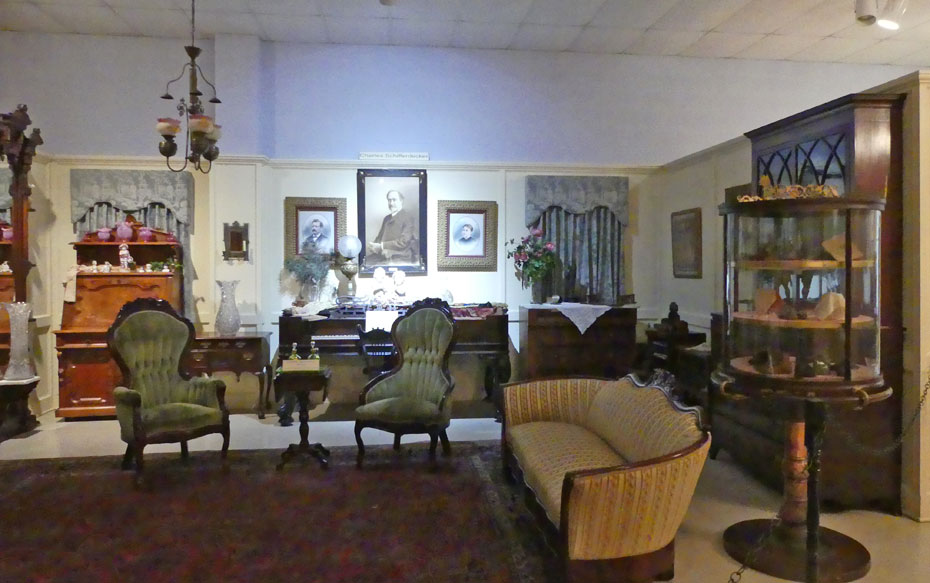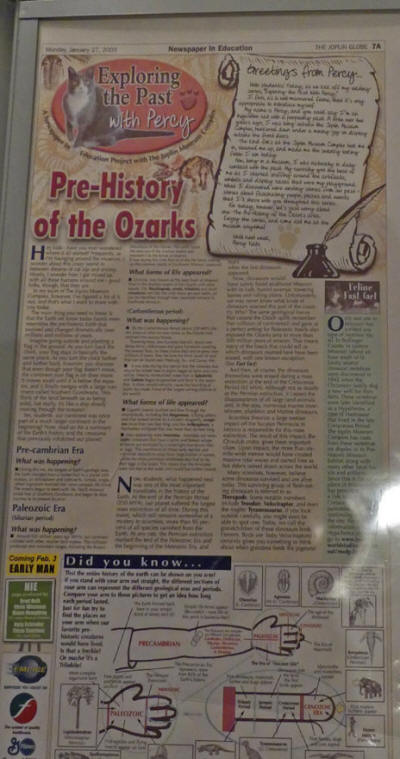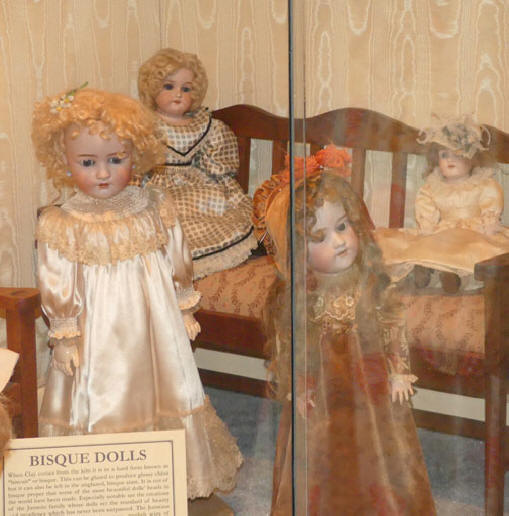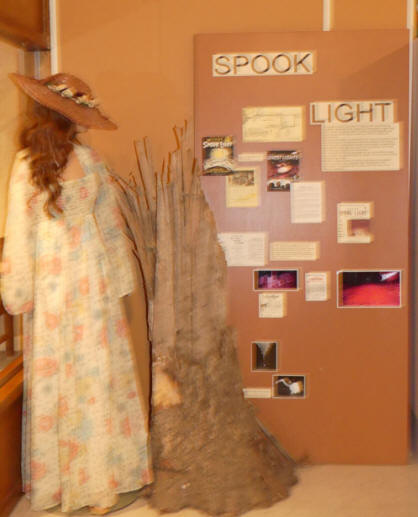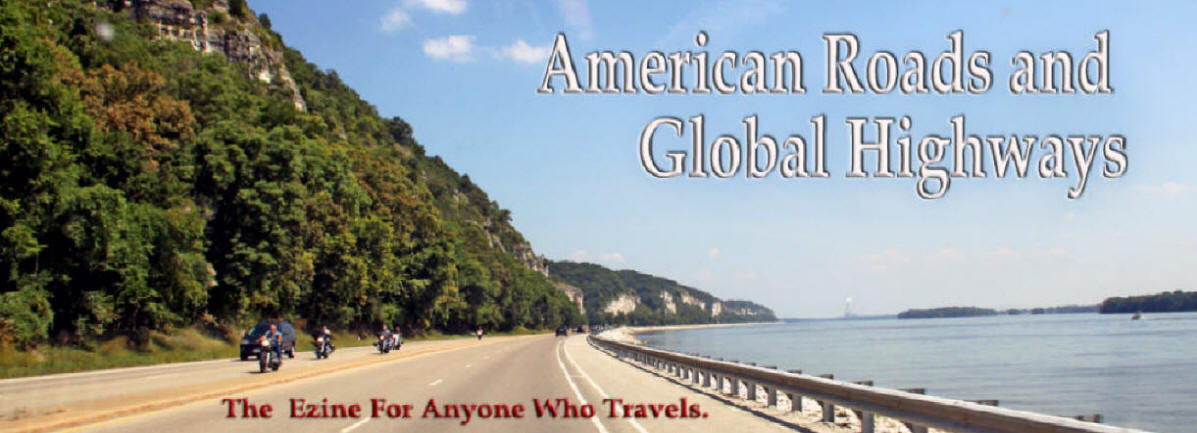
|
|
|
|
|
Editor's note: I was saddened to find that since I worte this story, Percy has crossed over the Rainbow Bridge. The musuem is still a great place to visit and when you go think of Percy.
How often do you find a cat in a historical museum? Add to that how often does said cat "write" for a local paper? Well, meet Percy, the greeter for Joplin History and Mineral Museum. I was introduced to him on a recent visit to the museum by Brad Belk, museum archivist and community historian. Percy is remarkable modest considering his fame. He studied me carefully with his wise amber eyes than granted me the privilege of allowing me to pet his sleek gray and white body.
Percy has had his share of adversity. Abandoned and found under the lawn sculpture in front of the museum at a young age, he found his niche here. Later he was the victim of a catnapping but was returned. Recently he had serious cancer and needed treatment thus the large white spot on his side. We also met Crystal, the next cat to move into the museum. She surprised them with 6 kittens. Brad assured us, "Crystal will not have any more kittens."
All but one of the litter has been adopted. That one, Roxie, remains at the museum as part of its feline staff. Although Percy normally doesn't like other cats (he is fine with dogs and kids), he has come to accept Crystal and Roxie. This assures that when it is time for Percy to go to the Rainbow Bridge, Crystal will take up his official duties. Since Percy was busy eating his canned food snack, Brad led us on the tour. The museum is actually two museums; Everett J. Ritchie Tri-State Mineral Museum and Dorothea B. Hoover Historical Museum.
We started in the mineral museum. Brad told how, "Lead and zinc put Joplin on the map. It was dangerous work done in large tunnels. These tunnels were so big that trucks were driven inside them. The trucks were disassembled and brought down through smaller shafts. " Mills ground out mountains of chat or waste from the lead and zinc. It was once used as a base for roads and railroads. Now chat is confined to places where it cannot contaminate the environment.
Some of the exhibits tell the other side of the mining story, about the owners, like Charles Schifferdecker, who became rich by buying up land used for the mines. Mining ended in the late 1960s because it was able to be outsourced and mined cheaper in other countries.
The mineral museum doesn't stop with just Joplin and the tri-state area. There are some fascinating exhibits on prehistoric uses of rocks and stone. They show how we as humans progressed from Stone Age weapons and tools to modern ones. There are exhibits of early mining done by animal power and 20th century mining machinery.
The florescent exhibit is one worth seeing. The difference between certain minerals under regular light and under black light is amazing. The Dorothea B. Hoover
Historical Museum tells the story of Joplin the city
although that is inevitably tied to the mining. As in
any boom town, many got rich from the mining operations.
The town prospered and one of the most notorious buildings that arose was called The House of Lords. The museum has several artifacts from that infamous business. The first floor was a fine restaurant and bar, the second was a gambling palor. It was the third that was most notorious. It was a brothel graced by the Ladies of the Evening and very popular with the Lords.
Another less-than-legal group also graces the museum. The Bonnie and Clyde exhibits tell of the narrow escape the criminals made in April 13, 1933. They had just returned to their rented apartment after robbing a tourist camp when five cars of law enforcement pulled up and a shoot out erupted. Two police officers were killed. A lot of costume jewelry and clothing was left behind. But the most important item was an undeveloped roll of film which made it easier to identify them and other gang members leading eventually to their shooting death in Louisiana a year later. The roll of film sold for about half million dollars a few years ago.
The museum takes you through every facet of Joplin life in earlier times. There's a 1927 American LeFrance fire engine. There are exhibits showing life in Joplin in private homes and the period furniture makes you wish for another such golden age although I would miss my computer and cell phone.
There is so much to see in the Joplin Museum. There is even an exhibit about Percy's published articles. After all, how often do you have such a wise cat in a museum? Then there is the Cookie Cutter Exhibit which has you realizing there are cookie cutters in every possible shape. Incidentally, Percy says he loves cookies. There's the Dolls Exhibit, filled with everything from porcelain dolls to very realistic ones.
Just next to the most beautiful bisque dolls is an exhibit called the Joplin Spook Light. The Joplin Spook Light is a mysterious floating light that appears in a small area near Joplin called the "Devil's Promenade" on the border with northeastern Oklahoma. There are several legends attached to the origin of the light. The museum cites one related to the Civil War where a Confederate captain who had a bad reputation for killing captured enemy soldiers was captured and decapitated by cannon fire and is still searching for his head. There are earlier ones related to Native Americans either star crossed lovers or one killed on the Trail of Tears. The Army Corps of Engineers studied the light and listed it as a "mysterious light of unknown origin." Some claim that it is car lights from Route 66. However Route 66 wasn't built until 1926. In 2014, a professor at the University of Central Oklahoma claimed he could prove the source of the light was car headlights and taillights and in April 3, 2015, a film was released using this explanation to explain the Joplin Spook Light. Well maybe, but how does that explain that the light was commonly seen in the 1880s and the first gasoline powered car in America was produced and road-tested by the Duryea brothers of Springfield, Massachusetts on 21 September 1893, on Taylor Street in Metro Center Springfield. Even without the Percy the cat and the Joplin Spook Light, this is a unique museum. With them added in, it's irresistible. For more info:
|
Connect with us on:
American Roads and | ||
|
Public Disclosure--
Please Read I recently learned of a FTC law requiring web sites to let their readers know if any of the stories are "sponsored" or compensated. American Roads and Global Highways' feature writers are professional travel writers. As such we are frequently invited on press trips, also called fam trips. Most of the articles here are results of these trips. On these trips most of our lodging, dining, admissions fees and often plane fare are covered by the city or firm hosting the trip. It is an opportunity to visit places we might not otherwise be able to visit and bring you a great story. However, no one tells us what to write about those places. All opinions are 100% those of the author of that feature column. |
|||
|
Privacy Policy/ Archives /
Contributors /
Subscribe to
American Roads Books by
Kathleen Walls /
Contact /
Sponsor or Advertise/ American Roads & Global Highways Home Page
|
